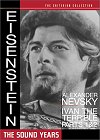S & H Film Review
Eisenstein/Prokofiev: Alexander
Nevsky, Lilli Paasiviki, Philharmonia Orchestra, Brighton Festival
Chorus, Vladimir Ashkenazy, RFH, 11th March 2003 (MB)
Eisenstein: The Sound Years, Alexander Nevsky (1938) & Ivan the Terrible
(1945-6), 3 discs, Criterion Edition, region coded 0.
Immediately after the opening credits have rolled, Eisenstein’s film focuses on a shot of a human skull and a skeletal animal carcass; accompanied by the icy glissandi of Prokofiev’s score it is a perfect fusion of film and music, a symbiosis of the despair and decay that comes to symbolise the invasion of the homeland.But, just as Alexander and his people are yoked to the hordes of Genghis Khan so Eisenstein is to an historical imperative that sought to resurrect the present in the past. Eisenstein’s first film for nine years (and his first in sound) it was at once a xenophobic attack on Germany and a paean to the glorious Soviet Republic; its glory is to invoke the historical as a mirror for the present. Released to critical acclaim in 1938, it was discreetly mothballed when Stalin signed the Nazi-Soviet Non-aggression Pact in 1939, only to be re-released when Germany invaded the Soviet Union in 1942. If not Eisenstein’s masterpiece, Alexander Nevsky is certainly one of the greatest films of its time, propagandist though it maybe (and no better nor worse than the films of Leni Riefenstahl because of that).
Eisenstein’s use of dialogue is sparing; he prefers instead to assimilate image and music. Prokofiev’s stirring choruses (perhaps a little underwhelming in this live performance of the complete score with a showing of the film) herald the voice of the people but it is the scope of the camerawork, with its enormous panoramic scenes, which makes the film such a spectacle. Vast open spaces – whether of the marshes at the beginning of the film, the devastated cities at its centre, or the preparation for the Battle on the Ice near the end – lend Alexander Nevsky a cinematic perspective which recalls, and looks forward to David Lean’s Lawrence of Arabia. Those very battle scenes – filmed from a distance, then close up – recall another propagandist film, Olivier’s Henry V, and scenes such as the cracking of the ice sending the heavily armoured, horned-helmeted Teutonic knights sinking to the bottom still astonish for their freshness and virtuoso technical achievements.
Dominating the film is the central performance of Nikolai Cherkasov as Alexander. Eisenstein films him close-up to emphasise his height and authority, many times placing him centre screen, but with a touch of irony this blond-haired, bass-voiced actor more than resembles one of the Aryan Nords the film is designed to depict as axiomatic of the invaders (and they themselves are more likely to be hirsute and darker than their Teutonic ancestry rightly suggests they were).
There is no doubt that films such as this – limited as they are by sound quality, if not picture quality - benefit from a live performance of the score. With a conductor like Ashkenazy in charge that brings its own problems – a Russian directness which focuses on the brass at the expense of the strings; too often trumpets and trombones seemed engaged in their own battle of wills. At moments – especially during the battle, which is not wholly orchestrated – indeed, the actual grittiness of the clashing of metal against metal is performed without music – Prokofiev’s score came across as less subtle than it is. Bells rang out with penetrating loudness, almost as if they would shatter the bell-towers they were supposed to recall on screen.
But, there was no doubting the passion with which the Philharmonia played this score and their virtuosity was often of the highest order (even if they come in late at certain moments). Ashkenazy coaxed luxurious string tone during the girl’s lament – beautifully, and hauntingly, sung by the Finnish mezzo Lilli Paasiviki – and the closing peroration with orchestra and chorus in full cry couldn’t fail to raise to roof. Subtle it might not have been, but it added immeasurably to the underlying power of Eisenstein’s epic tableaux.
There are few recordings of Prokofiev’s complete score but of the familiar suite the greatest recordings are those which appreciate the deftness of Prokofiev’s colourful – and prismatic – writing. Chief amongst them are Fritz Reiner’s superb, incandescently played Chicago Symphony Orchestra recording (RCA 09026-68363-2 review) and Karel Ancerl’s blistering Czech Philharmonic performance (Supraphon 11 1948-2 911). For a more modern sounding interpretation Claudio Abbado’s with the London Symphony Orchestra takes some beating (DG 447 419-2).
There is only one version of the film to obtain on DVD – and that is the Criterion edition, part of a three disc set including Eisenstein’s Ivan the Terrible. Its advantage over other editions of the film is that it has been extensively restored in terms of both image and sound quality in a wide-ranging digital transfer. Included on the disc are production stills, a new translation, a multi-media essay by Russell Merritt on the Eisenstein/Prokofiev collaboration and an audio essay by David Bordell. Expensive though it may be, Eisenstein: The Sound Years is indispensable.Marc Bridle

 Return to:
Return to: